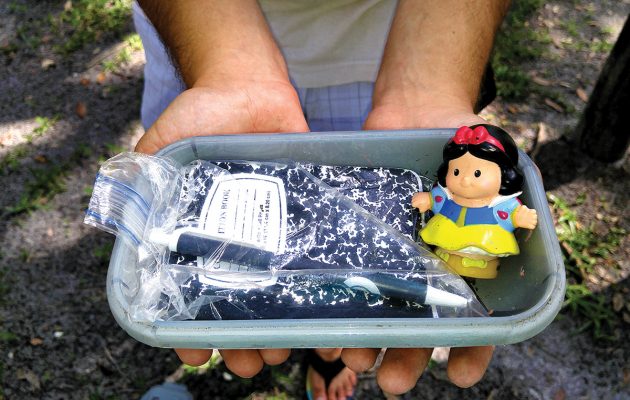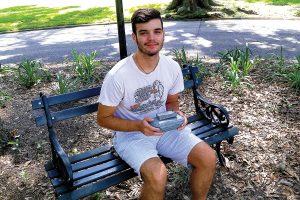Geocaching a high-tech game of hide-and-seek in Historic Districts

Jacklyn Cogburn of 5 Points remembers her first “find” in the parking lot of the Golden Corral on Normandy Boulevard. She and her fiancé Beau had just started dating. He’s a serious geocacher with over 500 finds.
“We went to breakfast and he said there’s one in the parking lot, and we went out and found it,” Cogburn said. “I was instantly hooked.”
Evan Brown, a St. Nicholas resident, can’t remember his first find. He’s not even sure how old he was when his dad turned on the GPS in the car and took him on his first hunt. He thinks he was about 10, maybe younger. He’s 22 now and a student at Jacksonville University, where he’s majoring in music and minoring in geographical information systems (think digital mapping), a useful skill in geocaching.
What are geocaches? You pass them all the time. The water-tight containers or caches are secreted in parks, monuments, businesses, churches and in the middle of nowhere. They contain a logbook and trinkets, some of them trackable. The coordinates of their locations are posted on geocaching.com.
Brown calls geocaching “a geeky treasure hunt.”
Since it started in 2000, geocaching has grown in scope and complexity with about 3 million geocaches around the world. About 200 of the 800 in the Jacksonville area are in San Marco and Riverside/Avondale, Brown said.
Players, using smartphones or GPS devices, track the location. When they find the cache, they write their name in the logbook and enter it into their device.
What’s the point? The thrill of the hunt, a chance to explore nature and new places and, of course, bragging rights.
Brown said he has logged about 200 geocaches, most of them in Jacksonville, but some he found during family trips to Indiana, Tennessee, North Carolina and Georgia. Cogburn has found about 50 in the year and a half she’s been on the hunt.
A geocache can be as small as a thimble or as large as a five-gallon bucket, anything at all really, as long as it is water tight. Ammo cans are a popular choice, as are plastic containers like Tupperware.
Some caches contain trackable trinkets. The rule is: Take one, leave one. Players exchange a trinket in a cache for one of their own with the understanding they will leave the trinket they’ve taken in another cache.
With the tracking number, the owner of the cache can follow the travels of the trinket. They can end up across town, or across the country. Sometimes the owner of the cache has a destination in mind for a trinket. For instance, someone left a Snoopy toy in a cache in Texas and asked that it be moved along the geocaching network until it reached the Snoopy statue in St. Paul, Minn.
The caches are given a difficulty rating, from zero to five stars, mostly determined by the terrain. Most of the caches in the San Marco and Riverside areas are easily accessible in parks and around buildings. Brown’s friend hid a cache under one of the lions on the fountain in San Marco Square, and it took him a year to find it.
The five-star caches are more challenging. They can involve hiking or paddling, sometimes only at night, or require solving a series of puzzles to get the clues to find the cache.
“My favorite was one where you had to build something out of Legos and match it to the hint,” Brown said. “I’m a 10-year-old around Legos. That was such fun.”
Geocaching is designed to be an inexpensive family activity that gets people out in the fresh air, exploring nature and historic sites. It also provides fun lessons in problem solving and map reading. Both Boy and Girl Scouts have geocaching badges.
Jacklyn and Beau take his 9-year-old son geocaching. “Whenever we don’t have anything to do, we’ll go hunting for geocaches. It’s the most exciting thing for him. We’ll let him find it and sign the log. He’s gotten a cool card game, a Ninja turtle, bouncy balls. He loves it.”
Geocaching also is popular because it’s free, though a $30 premium membership gives people access to group events and first alerts for new caches.
Group events often link geocaching to another activity such as community cleanups or tree planting. JaxParks is having its sixth annual Geocaching Challenge from 10 a.m. to noon Sept. 2 at Blue Cypress Park Community Center. The first 100 geocachers to complete the challenge get a trackable Geocoin.
But as with anything in life, there are rules.
Geocachers agree to keep the specifics of where caches are hidden a secret. Hints are okay, but no spoilers. And signing the log is important because caches that don’t get found get archived or marked missing. Oh, and that’s another rule – bring a pen.
Caches are sometimes raided for their trinkets or missing entirely. No one is sure whether the caches are stolen or just thrown away by someone who didn’t know what it was. “It’s heart breaking, you get to the hide and there’s nothing,” Cogburn said.
There are rules about hiding caches, too. Careful consideration is given to locations. Caches shouldn’t be too close together and property owners must be agreeable. A proposed cache is submitted to the website for approval and then posted. Premium members get first crack at the find.
Geocaching also involves housekeeping. Players replace logbooks that are filled or damaged and keep the area about the cache clean and looking undisturbed.
“I love the aesthetics of geocaching,” Brown said. “You can connect with nature and beauty. You can connect with other people. It’s absolutely my favorite apart of childhood.”
Brown shares one last memory.
“My parents and I were on our way back from Fort Clinch when I yelled, ‘stop the car!’ We were really close to a geocache and so my parents waited on the road while I went into the woods and found it.”
By Lilla Ross
Resident Community News







